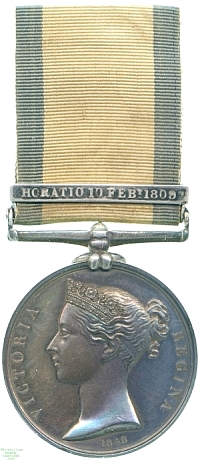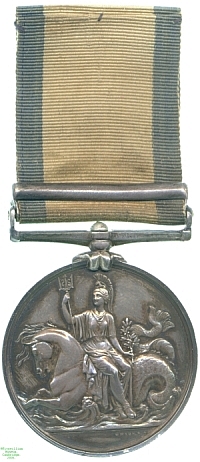
Obverse, a bust of Queen Victoria

Reverse, Britannia with a trident seated sideways on a seahorse

Obverse, a bust of Queen Victoria |

Reverse, Britannia with a trident seated sideways on a seahorse |
Just as in 1848 the extensive land campaigns of the Napoleonic Wars and the other conflicts of the pre-Victorian era were recognised by the issue of the Military General Service Medal, those serving in the Navy at the time were recognised with the Naval General Service Medal. As with the Army equivalent and the East India Company's related award, many of the battles for which the medal was awarded had been fought so long ago that few if any claimants survived.
In addition, bars were awarded for many actions whose significance and size were, despite the heroism displayed by those involved, relatively minor. The result was that many of the bars were issued in tiny numbers, with some combinations all but unique, and the medals command a very high price among collectors because of this rarity and individuality. This in turn, along with the manufacture in most cases of more bars than were eventually issued, has led to the `improvement' of many common awards where recipients' names are shared with those present at `rarer' battles. The medal also shares with the Military General Service and Army of India Medals the oddity that Queen Victoria, whose portrait they bear, was not the ruler under whom the battles for which it was awarded were fought.
The island of Guadaloupe, in the Caribbean, had been through a bewildering number of changes of ownership by 1809, at which point it was in French hands and therefore under British blockade. On 10 February the French frigate Junon, attempting to run the blockade, came up against the British sloops HMSS Asp and Supérieure, the latter of which gave chase until she was able to run the Frenchman towards HMS Latona, and also into the fire of the 5th-rate frigate HMS Horatio, which did sufficient damage to Junon that she was forced to surrender when other vessels engaged. Her captain, who was wounded, refused to hand over his sword except to an officer from Horatio since it was that vessel that had brought them to submission. As a result, in 1849, it was Horatio and Supérieure's crews who were awarded bars to the NGSM for this encounter, not Latona's. Only 1 of Supérieure's complement remained to claim, and only 13 of Horatio's. Guadaloupe would be taken over by the British in 1810, by which time the French had recaptured the Junon.
This medal is inscribed to James Smith. While such a man did serve in Horatio at this time, the Medals Roll does not confirm the award of a medal to him, and the clasp does not share the wear and discolouration of the medal itself. It is likely therefore that the recipient's extremely common name has been taken advantage of to create a fake medal/clasp pairing. Be this as it may, Lester Watson purchased this medal from the dealer Gifford at some point before 1928.